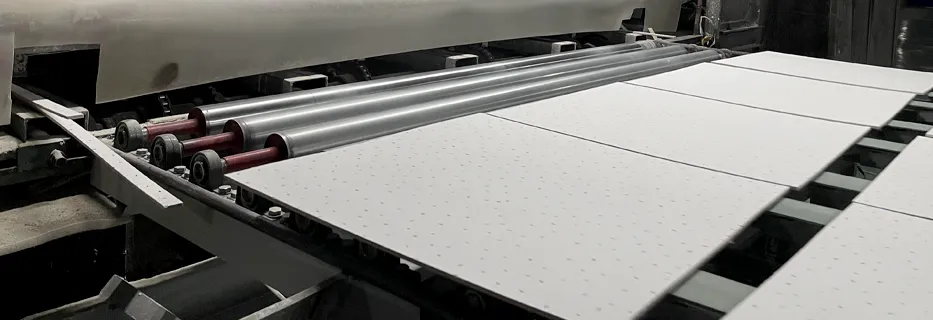Nov . 29, 2024 11:23 Back to list
Understanding the Materials Used in Ceiling Grid Construction and Design
What is Ceiling Grid Made Of?
Ceiling grids are an essential component of modern architectural design, widely used in both residential and commercial buildings. These structures not only support the ceiling tiles or panels but also provide a framework for lighting, HVAC systems, and other utilities. Understanding what ceiling grids are made of and their various components can enhance not just aesthetic appeal but functionality as well. This article delves into the materials and construction of ceiling grids, shedding light on their features, advantages, and various applications.
Materials Used in Ceiling Grids
The materials used in ceiling grids can vary based on their purpose, location, and design requirements. Here are the primary materials used in ceiling grids
1. Metal The most common material for ceiling grids is metal, particularly galvanized steel or aluminum. Metal grids offer significant strength and durability, making them ideal for commercial spaces that require a long-lasting solution. Galvanized steel grids are coated with zinc to prevent rust and corrosion, ensuring longevity in humid or moist environments, such as kitchens or bathrooms. Aluminum grids, on the other hand, are lightweight and resistant to corrosion, which makes them a suitable choice for high-humidity areas.
2. Wood In specific residential and specialized commercial applications, wood can also be utilized to create aesthetically pleasing ceiling grids. Wood grids can provide a warm, natural appearance and can be treated to offer different finishes to match the decor of the space. However, wood is generally more susceptible to environmental changes and moisture, so it is often used in controlled environments.
3. Vinyl Vinyl is a less common material for ceiling grids but can often be seen in low-cost or temporary installations. Vinyl grids are lightweight and resistant to moisture, making them suitable for certain commercial applications. Although they may not offer the same durability as metal options, they are cost-effective and easy to install.
4. Composite Materials Some ceiling grid systems utilize composite materials that combine multiple substances to achieve specific properties. Composites can be designed to be lightweight, durable, and aesthetically versatile. These grids often offer environmental advantages, as many composite materials are manufactured with sustainability in mind.
Types of Ceiling Grids
Understanding the types of ceiling grids is essential in selecting the right one for your project. The most commonly used types include
1. Suspended Grid Systems Suspended grid systems, also known as drop ceilings, consist of a grid framework that hangs from the ceiling joists above. This type of grid is excellent for concealing plumbing, wiring, and ductwork, and it allows for easy access to these systems for maintenance.
what is ceiling grid made of

2. Direct-Attached Grids Directly attached grid systems are installed directly onto the existing ceiling, eliminating the gap created by a suspended ceiling. This method is ideal for spaces with low ceiling heights where a drop ceiling is not practical.
3. Acoustic Grids Acoustic ceiling grids are designed specifically for enhancing sound quality within a space. They are often used in offices, schools, and auditoriums, where managing sound is crucial. These grids can hold acoustic tiles that absorb sound, minimizing noise pollution and enhancing the auditory experience.
Advantages of Ceiling Grids
Ceiling grids offer several benefits beyond their structural integrity. For instance
- Aesthetic Appeal Ceiling grids allow for various design options, enabling architects and interior designers to create visually appealing spaces. They can be finished in various colors and textures, allowing for seamless integration into any design scheme.
- Accessibility The suspended nature of many ceiling grids offers easy access to electrical and HVAC systems, facilitating maintenance and repairs without significant structural changes.
- Flexibility Ceiling grids can accommodate different types of ceiling tiles or panels. This versatility enables users to customize spaces according to specific needs or preferences easily.
- Sound and Thermal Insulation Many ceilings installed in grid systems also provide insulation that reduces sound transmission and enhances energy efficiency.
Conclusion
Ceiling grids serve a fundamental role in the construction and design of modern spaces. Made predominantly from metal, wood, or composite materials, these frameworks not only support the physical ceiling but also contribute to the functional and aesthetic aspects of a building. By understanding the various materials and types of ceiling grids, you can make informed decisions that enhance both practicality and design in your architectural projects. Whether for residential, commercial, or industrial use, the right ceiling grid can transform a simple overhead space into a component of cohesive design and utility.
-
Quality Ceiling Trap Doors & Access Panels | Easy & Secure AccessNewsAug.30,2025
-
Durable Ceiling T Grid Systems | Easy InstallationNewsAug.29,2025
-
PVC Gypsum Ceiling: Durable, Laminated Tiles for Modern SpacesNewsAug.28,2025
-
Pvc Gypsum Ceiling Is DurableNewsAug.21,2025
-
Mineral Fiber Board Is DurableNewsAug.21,2025
-
Ceiling Tile Clip Reusable DesignNewsAug.21,2025







